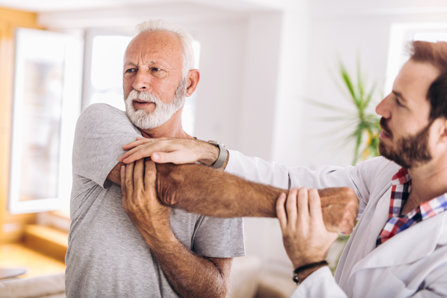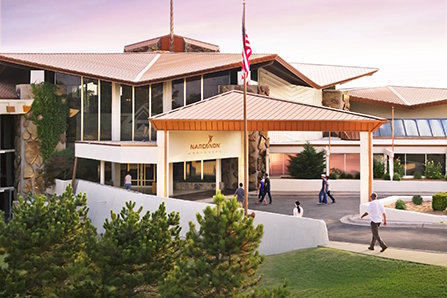Do We Really Need Addictive Pharmaceutical Drugs?

Let’s take a minute to openly and honestly ask, “Do we really need to use addictive pharmaceuticals to be healthy? Would it be possible to address physical pain without having to turn to potent prescription drugs?” Just a cursory glance at news headlines these days will show us the hardship of prescription drug addiction in America today. Is there a better way to be healthy and comfortable, without prescription drugs?
Where Our Reliance on Pharmaceutical Opioids Got Us
I’d like to quote the Centers for Disease Control and Prevention, the organization in charge of keeping Americans safe from severe threats to our health. Their paper on prescription opioids stated: “From 1999 to 2017, almost 218,000 people died in the United States from overdoses related to prescription opioids. Overdose deaths involving prescription opioids were five times higher in 2017 than in 1999. … Forty-six people die every day from overdoses involving prescription opioids.”
That is where the heavy use of pharmaceutical opioids got us. The American people were offered the “solution” to physical pain in the late 1990s. That solution came in the form of a pill bottle. Not only was it not a solution at all, but almost a quarter million people have lost their lives thanks to it.
Address the Cause of Pain, Not the Pain Itself
There is a peculiar factor in addressing pain relief that does not show up in most other sectors of medicine. Have you ever noticed how, in most fields of medical practice, medical experts aim to address the cause of a medical condition, if they can?
If a patient complains of frequent headaches, their doctor will attempt to find the source of those headaches and address that source. If a patient struggles with gastrointestinal difficulties, their physician will set up a series of therapeutic approaches designed to locate and treat the cause of those difficulties. If a patient comes to their doctor with a flu, head cold, fever, or some other bacteria- or virus-based illness, the doctor will work to address the virus primarily, not just the symptoms of the illness.
Medical practitioners are supposed to heal us by addressing the source of what ails us. So why then, when it comes to the standard patient complaint of physical pain, do doctors so often work to address the manifestation of the pain and not the cause of the pain?
For one thing, a great deal of money is to be made in treating the symptoms of a health crisis and not solving the crisis itself. In the case of pharmaceutical opioids, doctors and pharma companies make huge dollar figures every year treating patient pain. They would not make such figures if they truly solved pain for their patients. And to add to that, we are talking about the use of highly addictive and potentially lethal pharmaceuticals to “treat patient pain.” Would it not be better to address and solve the source of patient pain, if it were possible to do so?
How Do We Address the Cause of Pain?

The American Society of Anesthesiologists published an article on non-opioid approaches to patient pain. Many of these routes not only relieve pain, but they also address the source of the pain. Additionally, some other treatments can be mentioned. All are listed below:
- Physical therapy. Physical therapy involves working with a specialist who assesses the cause of pain in a patient and then creates a physical regimen of activity aimed at addressing the cause of the pain. For patients who struggle with back pain, pain in their joints, pain in their limbs, and so on, this is a great way to address the physiological cause of the pain and so find relief without medication.
- Acupuncture. An ancient Chinese medicine that’s been in use for thousands of years, acupuncture is one of the oldest methods of relieving pain that is still in use today. Acupuncture aims to address the flow of nerve energies within the body; relieving stopped flows in certain areas which could be causing pain. Acupuncture uses harmless needles inserted in critical parts of the body to accomplish this.
- Stem cell science. While still a budding science and not yet that far advanced, some success has been achieved with the use of stem cells for reducing pain. Much of what pains us comes from deteriorating bones, joints, tendons, and ligaments. The injection of stem cells into deteriorating areas can rejuvenate those areas, reducing pain and making those areas function well again.
- Chiropractic care. The spinal column is not only the area of the skeletal system which holds the body together, it is the major highway for the central nervous system. When out of alignment, the spine can impinge unpleasantly on nerve channels, thus creating pain. One of the most frequently cited sources of pain among pain patients is “back pain” according to Very Well Health.Chiropractic care can realign the spine as it is supposed to be, allowing nerve channels to flow appropriately. The result? A well-aligned spine, flowing nerve channels, and cessation or at least a reduction of pain levels.
- Non-drug treatments and at-home remedies. A lot of times, a person experiences physical pain as a result of their lifestyle or career. A farmer or gardener may have that “bum knee” that always acts up when a thunderstorm is about to break. A carpenter might have achy shoulders due to swinging a hammer all day. An office worker might have back pain as a result of sitting at a desk constantly. But these lifestyle and career choices are no reason to take mind-altering and habit-forming pharmaceuticals. Ice, massage, exercise, relaxation, knee pads, back braces, standing desks, and other simple remedies might be all it takes to address such physical pain.
So there are other methods for addressing physical pain. Unfortunately, because opioid pharmaceuticals are so popular and so heavily pushed by both the pharmaceutical industry and the medical sector, these alternative methods of addressing pain at its source do not get the attention that they deserve.
We need to change that. It’s time we demanded alternative approaches to pain relief. We need methods of relieving pain that are not only more effective than opioid pain relievers, but which also address the source of the pain, and which do it all without the highly dangerous side effects and addictive nature of opioid pharmaceuticals. In a nation with one of the best healthcare systems on the planet, is that really too much to ask?
Still Stuck on Painkillers?—Where to Turn for Help

When addicts hooked on pharmaceutical opioids come to Narconon Arrowhead for help, our aim is not only to help them overcome their addiction, but to also help them find safe, effective, non-opioid treatments for their pain. Our services would not be complete if we did not assist our students in addressing the mental, spiritual, behavioral, and physical aspects of our students’ addictions. We deliver the whole package, because only with a comprehensive and compassionate drug treatment program can addicts truly overcome their crisis and tackle life anew.
If you are seeking help for yourself or a loved one who is struggling with an addiction to the very pain relievers they were told would help them with their pain, reach out to Narconon Arrowhead today.
Sources:
- https://www.cdc.gov/drugoverdose/data/prescribing.html
- https://www.asahq.org/whensecondscount/pain-management/non-opioid-treatment/
- https://www.verywellhealth.com/conditions-most-often-associated-with-chronic-pain
Reviewed and Edited by Claire Pinelli, ICAADC, CCS, LADC, RAS, MCAP


